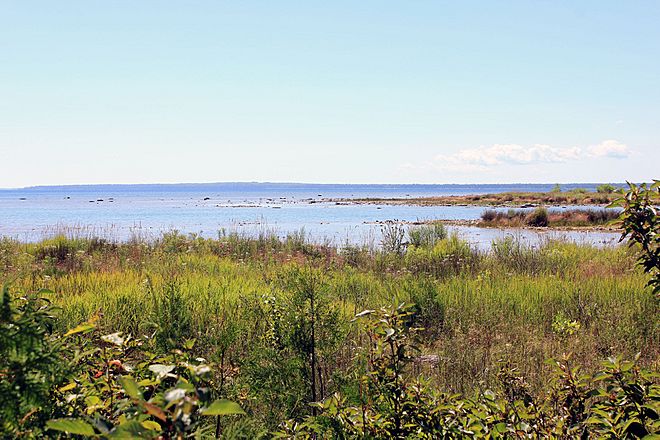Flora of Door County, Wisconsin facts for kids
| Select plants, fungi, and algae found in the county | |||
Door County, Wisconsin, is home to a huge variety of plant species. It's like a giant natural garden! This area is part of the North American Atlantic Region for plants, which means it shares many plant types with places along the Atlantic coast.
Contents
Discovering Plant Species
As of 2019, scientists have found over 1,200 different kinds of vascular plants in Door County. These include the beautiful yellow lady's-slipper (Cypripedium parviflorum), which is the official flower of the county! You can also find more than 250 types of mosses, liverworts, and hornworts here.
Plants on the Islands
Many islands around Door County have their own unique plant life. In 2001, experts made lists of plants on these islands. For example, Washington Island had 626 different species, while Rock Island had 333. Some smaller islands, like Sister Island, had only a few, and Gravel and Fish islands had no plants at all! Washington Island is also special because it's one of only two places in Wisconsin where you can find the rare green spleenwort fern (Asplenium viride).
Plants in the Lakes
Lakes in Door County are also full of interesting plants. In 2006, 60 types of water plants and algae were found in Clark Lake and nearby streams. This included a rare plant called spotted pondweed (Potamogeton pulcher), which is endangered in Wisconsin. In 2017, nine types of water plants were found in the Forestville Millpond.
Rare and Special Plants
Door County is a very important place for rare plants. It has plants that are found only here or in just a few other spots in the world. These special plants are protected in places like Plum Island, Coffee Swamp, Cave Point County Park, Whitefish Dunes State Park, and The Ridges Sanctuary. The islands of Grand Traverse are known for having some of Wisconsin's best rare plant areas.
Dealing with Invasive Plants
Sometimes, plants that are not native to an area can grow too much and harm the local plants. These are called invasive species. In 2019, people checked 25 miles of roadsides in Door County for these unwanted plants. They keep an updated map of places where you can find Japanese knotweed, Phragmites (common reed), teasel, and wild parsnip. They also track other problem plants.
Unique Plant Communities
Door County has some very special plant groups that you won't find just anywhere.
- Boreal Rich Fens: These are unique wetlands. They are called "rich" because the soil has a lot of minerals from a type of rock called dolomite. This makes the soil very fertile, helping special plants that love minerals to grow.
- Southernmost Boreal Forests: On the eastern side of the peninsula, you can find forests that are usually found much further north. In these forests, white cedar trees grow alongside other trees like balsam fir, even in places where you wouldn't expect to see cedar. This happens because the soil is alkaline (the opposite of acidic) and there's a lot of moisture from Lake Michigan. The special soil and moisture also mean that dead plants break down slowly, creating a thick layer of rich soil called humus.
- Dry Cliffs and Alvar: The Niagara Escarpment, a long cliff, has a "dry cliff" plant community. It's home to two rare types of whitlow grass. Other unusual areas are called alvars and Great Lakes alkaline rockshores. These rocky, open areas also host many rare plants.
Plants and Lake Levels

The water levels in Lake Michigan go up and down each year. When the water is high, it can kill off some plants. But when the water is low, new plants can start to grow in those areas. Even when water levels are high, plants can survive by spreading their seeds or growing new plants from their roots on higher ground.
Lake Michigan has more different kinds of shoreline plants than Lake Ontario. This is because Lake Ontario's water level is kept very stable by humans. If Lake Michigan's water level didn't change, the shoreline would be taken over by woody plants or strong water-loving plants like cattails or purple loosestrife. Wet meadows, like the one in the picture, do best when they don't flood too often, but still get enough water to stop big trees and bushes from growing.
Special Trees
Some trees in Door County are quite famous:
- One white cedar tree found on the escarpment was over 600 years old! It grew near other very old cedar trees.
- The biggest tree in the county is a 170-year-old eastern cottonwood. It's 110 feet tall and 35 feet around, found near Institute.
- In 1997, a new type of tree for Wisconsin, the striped maple, was found near Newport.
- In 1969, a new type of apple called the Viking apple was created. It's good at resisting diseases like apple scab and fireblight. You can see the original Viking apple tree at the Peninsular Research Station.
Mushrooms and Fungi
Door County is also home to many types of fungi, like mushrooms. As of 2019, 326 different kinds of mushrooms and other macrofungi have been found in the county. This includes some rare lichens, like Cetraria arenaria, which grows on the ground, and Anaptychia crinalis, which grows on tree bark.
Unique Yeast
In 2009, a very special type of yeast was discovered on fallen cherries near Fish Creek. This yeast, called Saccharomyces cerevisiae, was a mix of two different kinds: one usually found on oak trees and another from vineyards.

